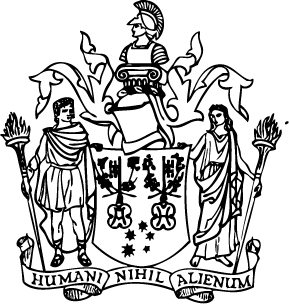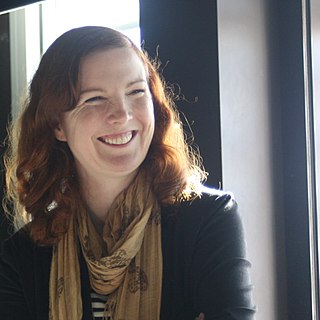
The Royal Society of Canada, also known as the Academies of Arts, Humanities, and Sciences of Canada, is the senior national, bilingual council of distinguished Canadian scholars, humanists, scientists, and artists. The primary objective of the RSC is to promote learning and research in the arts, the humanities, and the sciences. The RSC is Canada's national academy. It promotes Canadian research and scholarly accomplishment in both official languages, recognizes academic and artistic excellence, and advises governments, non-governmental organizations, and Canadians on matters of public interest.
Kathryn "Kate" Burridge is a prominent Australian linguist specialising in the Germanic languages. Burridge currently occupies the Chair of Linguistics in the School of Languages, Literatures, Cultures and Linguistics at Monash University.
Alexandra Yurievna "Sasha" Aikhenvald (Eichenwald) is an Australian-Brazilian linguist specialising in linguistic typology and the Arawak language family of the Brazilian Amazon basin. She is a professorial research fellow at Central Queensland University

The Australian Academy of the Humanities was established by Royal Charter in 1969 to advance scholarship and public interest in the humanities in Australia. It operates as an independent not-for-profit organisation partly funded by the Australian Government.
Nicholas Evans is an Australian linguist and a leading expert on endangered languages. He was born in Los Angeles.

Lorraine Jenifer Daston is an American historian of science. She is director emerita of the Max Planck Institute for the History of Science (MPIWG) in Berlin, visiting professor in the Committee on Social Thought at the University of Chicago, and an authority on Early Modern European scientific and intellectual history. In 1993, she was named a fellow of the American Academy of Arts and Sciences. She is a permanent fellow at the Berlin Institute for Advanced Study.
Andrew Kenneth Pawley, FRSNZ, FAHA, is Emeritus Professor at the School of Culture, History and Language of the College of Asia and the Pacific at the Australian National University.
Alan Francis Chalmers is a British-Australian philosopher of science and associate professor at the University of Sydney.

Stuart Cunningham is Distinguished Emeritus Professor of Communication and Media Studies at QUT.

Kate Crawford is a researcher, writer, composer, producer and academic, who studies the social and political implications of artificial intelligence. She is based in New York and works as a principal researcher at Microsoft Research, the co-founder and former director of research at the AI Now Institute at NYU, a visiting professor at the MIT Center for Civic Media, a senior fellow at the Information Law Institute at NYU, and an associate professor in the Journalism and Media Research Centre at the University of New South Wales. She is also a member of the WEF's Global Agenda Council on Data-Driven Development.
The Max Crawford Medal is awarded every other year by the Australian Academy of the Humanities in recognition of "outstanding achievement in the humanities by young Australian scholars currently engaged in research, and whose publications contribute towards an understanding of their discipline by the general public". It is funded from a bequest to the academy by Emeritus Professor R.M. Crawford. In 2019 it became an annual award.
Raymond Maxwell Crawford, was a leading Australian historian. He was Professor of History at the University of Melbourne from 1937 to 1970.
Matthew Spriggs is an emeritus professor of archaeology at the School of Archaeology and Anthropology of the Australian National University (ANU) in Canberra. He was educated at St John's College, Cambridge. He has made major contributions in the archaeology of Southeast Asia and the Pacific and is particularly well known for his work investigating the Lapita culture cemetery at Teouma in Vanuatu.

Elizabeth Anne CutlerFRS FBA FASSA was an Australian psycholinguist, who served as director emeritus of the Max Planck Institute for Psycholinguistics. A pioneer in her field, Cutler's work focused on human listeners' recognition and decoding of spoken language. Following her retirement from the Max Planck Institute in 2012, she took a professorship at the MARCS Institute for Brain, Behaviour and Development, Western Sydney University.
Simon During is a New Zealand-born academic and cultural theorist.
Joseph Lo Bianco is Professor of Language and Literacy Education at the Melbourne Graduate School of Education, University of Melbourne, and serves as Past President of the Australian Academy of the Humanities. From 2011–2017 he designed, led and implemented a 6-year, 3-country language and peace building initiative for UNICEF in Malaysia, Myanmar and Thailand. He has previously worked on peace building activities in Sri Lanka in the late 1990s, and in several other settings. He is a language planning specialist, recognised for his work on combining practical problem solving language policy with academic study of language problems. He has published extensively on bilingual education, English as a second/additional language, peace building and communication, multiculturalism and intercultural education, Asian studies, Italian language teaching and the revitalisation of indigenous and immigrant community languages.
Glenda Anna Sluga, is an Australian historian who has contributed significantly to the history of internationalism, nationalism, diplomacy, immigration, and gender, in Europe, Britain, France, Italy, Yugoslavia, and Australia.

Karl Alexander "Sander" Adelaar is a Dutch linguist. He is primarily interested in the Austronesian languages of Borneo, Madagascar, and Taiwan, as well as the Malayic languages. He also does research on the oral and literary traditions of Indonesia.
Ann Margaret McGrath is an Australian historian and academic. As of 2023 she is the WK Hancock Chair of History at the Australian National University.
William Bernard McGregor is an Australian linguist. As of 2024 he is professor in linguistics at Aarhus University in Denmark.






